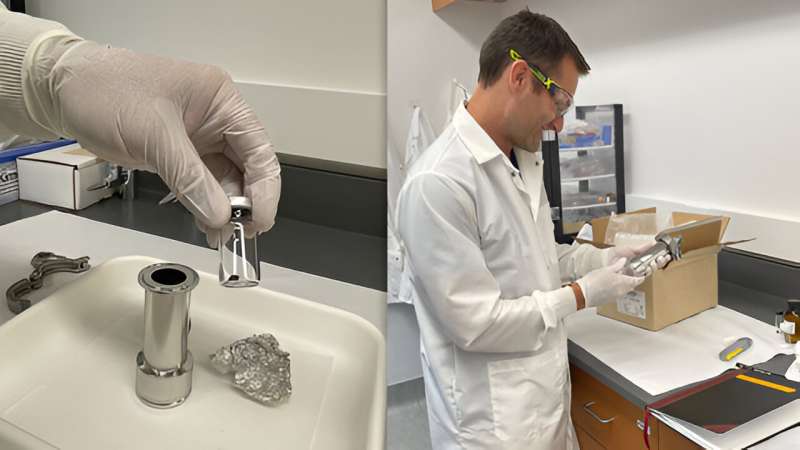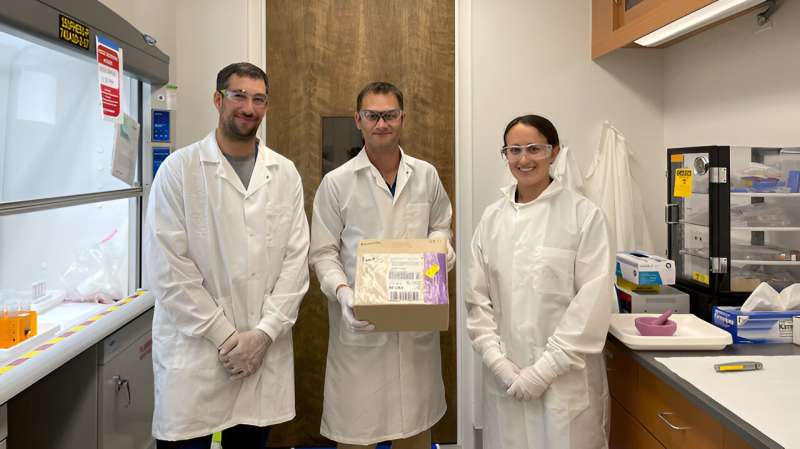This article has been reviewed according to Science X's editorial process and policies. Editors have highlighted the following attributes while ensuring the content's credibility:
fact-checked
trusted source
proofread
Bennu asteroid samples unveiled

In a discreet vacuumed-packed container inside a FedEx box lies a piece of ancient history; extremely ancient history.
The material, at just 120 milligrams, will provide information about the early solar system, planetary formation, and potentially, even life on Earth.
Lawrence Livermore National Laboratory (LLNL) scientists have recently received and will analyze samples from the asteroid Bennu that will help explain how it formed and from where it came.
Bennu is a small, carbon-rich near-Earth asteroid that passes close to Earth about every six years. It was the target of NASA's OSIRIS-REx mission to collect an asteroid sample and bring it to Earth. The spacecraft returned to Earth last fall, landing in Utah, with approximately 120 grams of Bennu tucked away on board.
"We're going to look at the composition of different elements to figure out where exactly this asteroid might have formed in the first place," said LLNL scientist Jan Render, one of the team members who opened the box from NASA.
An ancient relic of our solar system's early days, Bennu, at about one-third of a mile wide at its equator, has seen more than 4.5 billion years of history. Scientists think that within 10 million years of our solar system's formation, Bennu's present-day composition was already established.
Preliminary data by the LLNL team and others indicate that this larger asteroid likely formed in the outer solar system beyond Jupiter. Orbital research has shown that Bennu likely broke off from a much larger carbon-rich asteroid about 700 million to 2 billion years ago, probably spent some time in the main asteroid belt between Mars and Jupiter, and has drifted much closer to Earth since then. Because its materials are so pristine and the asteroid has never been heated above ~150 °C, Bennu may contain organic molecules like those that could have been involved with the start of life on Earth.
While the organic molecules will be studied elsewhere, Livermore scientists will analyze the inorganic components from Bennu that will help us determine when, where and how the asteroid formed.

"Asteroids are like fossils and can tell us what the solar system was like in the past," said LLNL scientist Quinn Shollenberger, another member of the team. "We can look back in time to when the sun was being born and how rocky planets formed."
The LLNL team believes that Bennu formed at the very start of the solar system, more than 4.5 billion years ago.
"This work will allow us to understand where and how this asteroid formed," said LLNL scientist Greg Brennecka, also a member of the team. "Bennu is a snapshot of what the solar system was like over 4.5 billion years ago. This work will tell us how far Bennu was from the sun when it formed and what that environment was like."
Bennu's controlled journey from space to Earth is really important because while the team has done this type of work on meteorites before, meteorites have all interacted with Earth's atmosphere and surface, which can cause changes to the sample.
"This sample is really important because it was collected in space, sealed and brought back to Earth with no interaction with the terrestrial system at all," Brennecka said. "This is a very pristine sample."
Livermore has a long history in cosmochemistry, the study of extraterrestrial materials—samples returned by space flight missions as well as meteorites and their components—with the goal of understanding the origin and evolution of the solar system and our cosmic neighborhood. The research includes the full history of the solar system, from before the protoplanetary disk began to coalesce and the sun formed, up until present.
In addition to measuring inherent isotopic variation to study the asteroid's origin, chronology is a major thrust of LLNL's research. Radioactive decay of isotopes from a variety of elements provides the potential to determine the age of a material anywhere from months to billions of years old. The team can measure the age of planetary and meteoritic materials with incredible precision, even with limited amounts of materials. The team has dated objects such as the first solids to form in the solar system, tiny bits of cometary material collected during NASA's Stardust mission, meteorites that formed beyond the orbit of Jupiter, rocks ejected from Mars by violent impacts and lunar samples returned by the Apollo missions.
LLNL researchers are applying these techniques to material collected on asteroid return missions to gain comprehensive insight into what type of material the solar system formed from and how it has evolved since its formation. Livermore was awarded samples from the asteroid Ryugu (Hayabusa2 mission, landed December 2020) and the asteroid Bennu (OSIRIS-Rex mission, landed September 2023).
Provided by Lawrence Livermore National Laboratory





















